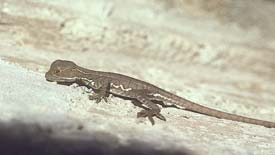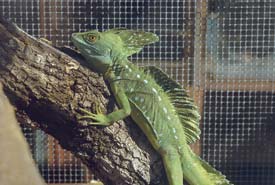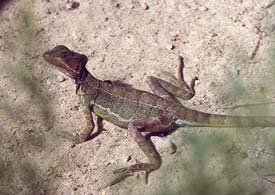Information on the green or plumed basilisk (Basiliscus plumifrons), common or brown basilisk (B. basiliscus), red-headed basilisk (B. galeritus) and brown or striped basilisk (B. vittatus).
In December 1988, I visited Panama to collect brown basilisks for a breeder colony. I saw a few crossing a muddy river in Panama City and wanted them as breeders. I swam to the other side near a bridge in town. I saw a naked Indian under the bridge washing himself, and he thought that I came to do likewise.
"¿Jabón?" he asked. This meant, "Soap?"
"No," I replied, "I am going to catch a few basilisks."
I reached into a nearby burrow that I saw the basilisks enter. I felt a hard bite – harder than a basilisk bite would be – on one finger. I yanked my hand out immediately, and there was a big crab hanging from my finger, pinching it.
"¿Para comer?" the Indian asked. This meant, "To eat." He thought my word for "crab" was "basilisk."
I left the basilisks where they were, in the burrow.

This juvenile red-headed basilisk will eat small superworms, normal-sized mealworms and crickets.
Introduction to Basilisks
Between 1989 and 1997, I bred almost 3,000 basilisks. I worked with three out of the four existing species, including the green or plumed basilisk (Basiliscus plumifrons), common or brown basilisk (B. basiliscus) and red-headed basilisk (B. galeritus). I never tried to breed the mostly imported striped basilisk (B. vittatus, also known as the brown basilisk).
Basilisks are very elegant and enjoyable lizards. They have beautiful bodies, especially the green basilisks. I only stopped breeding them because during the mid-1990s, many were imported and the prices went down.
The genus Basiliscus is found in Central and South America, ranging from Jalisco and southern Tamaulipas in Mexico southward to the northwestern coast of Ecuador. These lizards dwell along riverbanks and other water basins that provide sufficient sun exposure. Overgrown trees, reeds and other vegetation provide typical habitat.
Wild basilisks are rather flighty lizards. They engage in head bobbing and lots of climbing. They are good swimmers and can also hide underwater when threatened. Wild basilisks are also known to run on water, an ability that garnered them the nickname: Jesus lizard.
Species Descriptions
The striped basilisk's range spans from Mexico into northwestern Colombia. This species can adapt to a wide variety of habitats, but they are commonly found in drier areas up to 4,950 feet in elevation. Temperatures in B. vittatus territories average 62 to 83 degrees Fahrenheit in January and 73 to 92 degrees in July. A rainy season occurs in June through October, producing 4 to 7 inches of rain per month. Basiliscus vittatus reaches nearly 21 inches in total length, with a snout-to-vent length (SVL) of 6.8 inches. Males have a large crest on the head and a small crest on the back.
Green basilisks can be found in the southern regions of Nicaragua, Costa Rica and western Panama. They keep to the lowlands, where the temperature remains fairly constant, with cooler temperature ranges of 68 to 72 degrees and warmer temperatures averaging 88 to 93 degrees. Like striped basilisks, greens experience a distinct rainy season in their range, lasting from June to October. Basiliscus plumifrons is one of the larger basilisk species (along with the common basilisk) and can attain total lengths of up to 32 inches, with an average SVL of approximately 9.6 inches. I heard of one specimen that was reportedly 36.8 inches long. Males sport crests on the head, back and tail.
The common basilisk lives in southwest Nicaragua southward through northwestern Colombia (its subspecies, B. b. barbouri, is found in eastern Colombia and some parts of western Venezuela). It can be found at elevations up to 2,970 feet. Climate and rain patterns in its range are similar to those in the greens' range. They average 32 inches in total length, and SVL is approximately 9.6 inches. This species is sexually mature at a SVL of 4.7 to 5.4 inches, which occurs in the second year of age. Typical of basilisks, males again possess a crest on the head, back and tail.
The red-headed basilisk is the southernmost species, occurring in Panama, western Colombia and northwestern Ecuador. The smallest of the basilisks, B. galeritus can measure up to 28 inches with a SVL of roughly 7.6 inches (but most are smaller). Males have a large crest on the head. Little is known about the habitat preferences of the red-headed basilisk. Temperatures in its range are between 65 and 72 degrees on the lower end and 84 to 88 on the higher end. Rainfall averages 9 to 11 inches a month between January and March; during the rest of the year, the region receives relatively little rain.

Basilisks should be provided with plenty of branches for climbing and lots of plants for hiding. If possible, outdoor enclosures are ideal for them.
Captive Care
Basilisks are rather jumpy, but do fine in captivity when kept appropriately. They do not tolerate much handling.
Use of outdoor enclosures is recommended in places with appropriate climates. During the winter months, if necessary, basilisks should be brought indoors. I live in Alabama and kept all my basilisks outside from mid-April through mid-October.
They were kept in outdoor enclosures that were covered with plastic sheeting during cold nights. These cages were partially sunk 2 to 3 feet into the ground to help maintain a stable temperature. (The block or concrete walls in the ground acted like a buffer to maintain stable temperatures – much like a basement of a house.) The rest of the year, I kept the basilisks in heated setups in my basement.
Larger basilisks should be kept in enclosures measuring at least 4 feet square by 6 feet tall. Basiliscus galeritus and B. vittatus can be kept in smaller enclosures measuring 3 feet square by 5 feet tall. These are minimum cage sizes; the larger the setup, the better. Temperatures for captive specimens should mirror the temperatures found in the lizards' native habitat.
Basilisks should be provided with a forest terrarium with many climbing possibilities and shelters. Be sure any branches you place in their enclosures are clean and free of parasites. In addition to sturdy climbing branches, provide a large water bowl. This will need regular cleaning, as these lizards defecate in their water. This does often make general enclosure cleanup easier, however. I always kept my outdoor basilisks on normal soil. Peat, sphagnum or mulch can be used as substrates for indoor enclosures.
Basilisks kept indoors require a well-positioned (in a spot where it isn't too far away from the lizards) ultraviolet (UV) light. I recommend UVB lights made specifically for lizards (rather than UV lamps for plants). A basking hot spot, which can be provided by a spot light, should be heated to the mid-90s. Ambient temperatures should be in the 80s.
In drier climates or indoors, basilisks should be misted during a few months of the year to imitate the rainy season. Keep in mind that keeping any reptile in an evironment that is too moist can lead to bacterial or fungal infections; even the most water-loving herps want to dry out their bodies from time to time in the sun or under a lamp.
A wide variety of foods have been found in the stomachs of wild basilisks, including fish, frogs, small lizards and birds, as well as invertebrates, such as shrimp, ants, beetles, flies, grasshoppers, locusts, crickets and crayfish. Vegetable matter, including seeds, fruits, berries and leaves form a smaller portion of the wild diet.
I fed superworms to my basilisks every day, but they would also accept cockroaches (death's head roaches). Crickets are also accepted. Any insects offered should be gut-loaded with vegetables that are high in carotenes (commercial gut-loading diets are available as well). I recommend that indoor basilisks receive some calcium/mineral/vitamin supplements too.
Breeding Notes
I recommended keeping breeder basilisks year-round in groups of one male and two or three females. To stimulate breeding, mine were given a two- to three-month dry period during the winter. When basilisks are ready to breed, courtship behaviors observed are the usual head bobbing, etc.
My female basilisks nested in loose, black garden soil (potting soil without added chemicals such as fertilizers). In fact, basilisks and most lizards prefer black garden soil to sand for nesting. I noticed this again and again, when I had part of the terrarium (while breeding them indoors during the winter) set up with play sand and the rest with soil. I found that the lizards almost always avoided the sand and laid their eggs in the garden soil.
My lizards of various species (including Agama spp., Lacerta spp., Physignatus spp. and Basiliscus spp.) always prefer this nesting medium above all others. If you have breeding basilisks, place a large bucket of garden soil inside their enclosure, in which the gravid female can lay her eggs.
Common basilisk. In December 1988, Dr. Mark Paris and I visited Panama and obtained export permits for a number of common basilisk breeding pairs. I bred these lizards from 1989 to 1994. During this time, I was building Agama International and had limited time to make notes. Therefore, my notes on incubation periods are lacking.
Optimal breeding took place from May to September, while the basilisks were outside; a smaller peak of breeding success occurred in January, when they were brought inside. Eggs hatched approximately three months after breeding. Based on my records of hatching dates (see table), the results of the outdoor copulations were almost three times more successful than the indoor pairings.
The number of eggs per clutch varied from five to 15. The eggs were white when laid, but turned yellow after one to two weeks. I incubated the eggs in moist vermiculite, and they were completely covered in this medium. I did not weigh the water or vermiculite; I added water to the vermiculite until it felt slightly moist, like garden soil. Literature puts the incubation period at 60 to 76 days at a temperature of 86 degrees Fahrenheit and 110 to 113 days at 81 degrees.
Green Basilisk
Because of the greater demand for green basilisks, I started breeding them in 1990 and continued until 1997. Like B. basiliscus, the greens also bred more readily while they were outside. Maximum breeding activity occurred June through August. During their time indoors, they bred most readily during January.
The size of the freshly deposited eggs was 20 to 23 mm. The clutch sizes varied from five to 15, but the average was 12. I incubated the eggs at 82 to 85 degrees Fahrenheit in moist vermiculite. One time, the eggs were exposed for a short period to a temperature of 70 degrees, but they still hatched well.
I measured the incubation duration 13 times for B. plumifrons and found the following numbers, from shortest to longest: 54, 55, 56, 59, 60, 61, 62, 62, 68, 69, 78, 79 and 80 days. The average was 65 days.

Red-headed basilisks are harder to breed in captivity, as they are more delicate than the other basilisk species.
Red-Headed Basilisk
In November 1990, when I received some pairs of B. galeritus from Phil Romano and Dan Ferrena at New York Reptilia; I knew I had something very special on my hands. Virtually nothing was known about this species' reproduction. This encouraged me to take extra notes.
The animals started reproducing in their second year. Breeding took place about three and a half months prior to hatching. The majority of breeding activity happened from mid-April through mid-September. All young were born from August to January, which means that the only successful breeding attempts were those that took place outdoors. I collected eggs in the indoor setups, but they never hatched (unlike the eggs from B. plumifrons and B. basiliscus).
I once observed females laying eggs between 4 and 6 p.m. The number of eggs in these clutches was not very large; most clutches had five eggs. The egg size was nearly the same as that of B. plumifrons: 19 to 23 mm.
As I did with the other basilisk species, I incubated the eggs in moist vermiculate at 82 to 85 degrees Fahrenheit. I also measured the incubation period 14 times. These recorded incubation periods were, from shortest to longest: 69, 69, 70, 71, 71, 72, 78, 79, 80, 81, 81, 82, 85 and 89 days. The average incubation period was 77 days, approximately 12 days longer than that of B. plumifrons when kept at similar conditions.
Twice I measured hatchlings at birth. They were 3.5 inches long (SVL of 1.5 inches) and 3.6 inches long (SVL of 1.7 inches).
Of the three basilisk species I kept, the red-headed basilisk was the most delicate and difficult to reproduce.
Rearing Hatchlings
Most babies were kept in spacious cages measuring 6 feet tall by 2 feet deep by 3 feet wide with many branches for climbing. Twenty to 30 young were kept in these setups. The back wall of these cages had four to five heavily used hideboxes located at different levels. I kept young basilisks on regular soil or dirt (topsoil) indoors and out.
Water bowls were refilled daily. We used paint roller trays as water bowls for the young, because they are inexpensive, readily available and their built-in "ramp" makes it easy for the lizards to climb in and out of the water. When the babies were outside, these water bowls were always placed in the shade, as the sun would overheat the water. If the young jumped into sun-heated water that was too hot, they could die. During winter months, we avoided putting cold water into the bowls; otherwise, the babies could become paralyzed and drown.
Young basilisks should always be kept at a temperature above 60 degrees Fahrenheit; however, a short exposure to temperatures down to 45 degrees will not kill them. I tried to keep night temperatures above 60 to 74 and, during the day, 75 to 95 degrees. Indoors, I maintained the young in the 65- to 70-degree range at night and the 80- to 90-degree range during the day. I also provided the previously mentioned UVB lighting and a hot spot.
Feeder insects, such as small superworms, normal mealworms and crickets, were offered to the young daily.
I also added vitamin D3 to the water to prevent metabolic bone disease. Despite the supplements, the babies that were reared indoors began cramping up and seemed paralyzed. It became clear that these youngsters somehow could not make use of the vitamin D3 and needed UVB lights or direct sunshine in order to prevent cramping, which is a sign of calcium deficiency.
Basilisks are very beautiful and elegant lizards that can be kept very well in capivity, if sufficient space and the right microclimate conditions are offered. These lizards are best kept as a show animal in a well-planted vivarium with lots of branches; they are not suited to handling.
Of the four basilisk species, the green basilisk is the best choice for a captive. Second is the common basilisk. The red-headed basilisk is the most delicate of the species and is only suitable for more advanced terrarium keepers. This species is also harder to find in the pet trade.
Basilisk Health Concerns
Like other lizards, basilisks can suffer from parasites, ranging from nematodes to flagellates and coccidia. A thorough vet exam is highly advised for newly purchased animals, especially if they are wild caught.
Basilisks live in a green environment, where they consume prey items that contain leaves in their gut. These leaves are a natural source of vitamin A (carotenes) for the animals in the wild. If basilisks are kept in the terrarium, they often receive insects that do not have enough carotenes. When the enclosure is dry and dusty, this quickly leads to blurred eyes and eye infections. The dust irritates the eyes, while the lack of vitamin A reduces the ability to fend off parasites. While it is possible to overdose on vitamin A, I highly recommend gut-loading prey items with carrots, sweet potatoes, tomatoes or leaves.
Rostral injuries can result from accidents, such as when a basilisk bangs its nose against the glass or wire walls of its terrarium. A panicky basilisk will run with full speed into glass and hurt its nose. Rostral trauma can be followed by disease, when wounds on the nose become infected. The best way to prevent such injuries is by limiting the number of glass walls in the basilisk enclosure to only the front (with the other walls being wood, plastic, etc.) and to provide sufficient hiding places, so that the animals feel secure. Another possible solution is to cover the lower portion of any glass walls with an opaque material (paper or fabric), so there is a visible barrier the basilisk can see and avoid running into.


